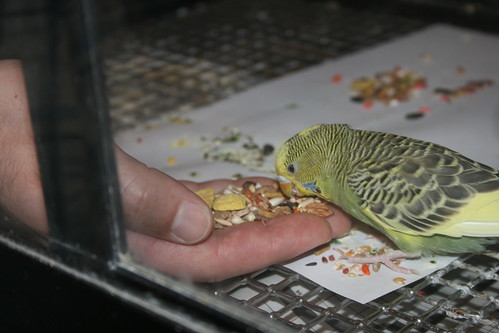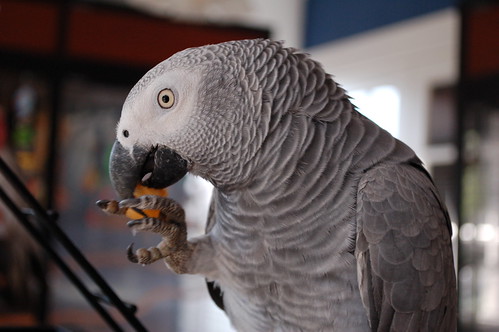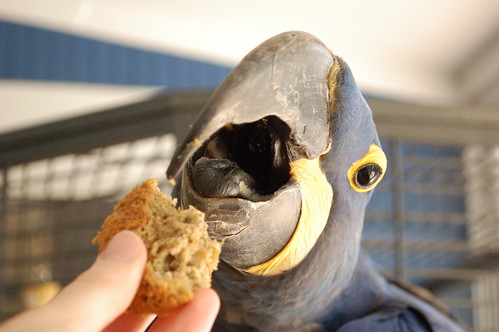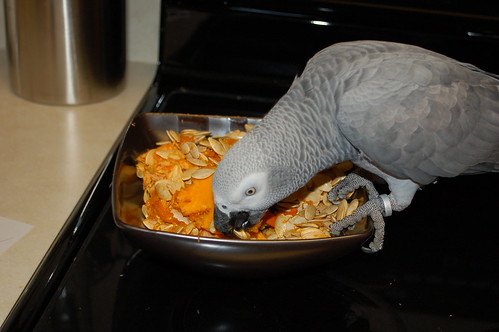Can I Feed My Bird a Seed Mix With Fruits and Veggies
It is my firm belief that providing a proper diet is our #1 responsibility to our birds. As long as we keep wild creatures in a cage, and at our mercy, it is imperative that we at least give them that which they need to maintain their health, both mental and physical.
Many of us have parrots who have come to us with serious diet issues whether they have been re-homed or have come from a pet store. In this age of information there are still many, many parrots living on an all seed diet. It is appalling to me how many people don't have a clue as to the needs of the pet they have brought into their home and don't bother to investigate. I applaud you for looking here to find out how to care for your bird.

The problem here is not with the seeds themselves. They are an important part of a wild bird's diet, but not the only part by far. Seed alone does not fulfill the dietary requirements of any bird, wild or otherwise.
Bird's with seed only diets will fall victim to the many illnesses that come from vitamin deficiency. She will face a life of inadequate strength and energy, a system that does not maintain itself properly and poor immune system functions. She will require medical attention more often as her health deteriorates, and her life span may be cut short.

A wild parrot feeds on most of the same food groups as we humans do, with the exception, perhaps, of meat, which I don't object to offering in conservative amounts. The fact is, we really don't know what exactly a wild bird eats in her native habitat. We can only go by that which field researchers have been able to observe parrots eating, which does not account for a large part of their foraging day. Avian science has determined what their bodies require and a captive diet is based on this knowledge. Life in urban and rural communities may not provide the things that they would elect to eat in the wild, so we do the best we can to supply adequate substitutions with what is available in our supermarkets. So far, it seems to be working out fairly well, as long as we can get them to eat what we give them.
If you have taken on a all seed eater, switching her to a proper diet can be a daunting, but do-able, task. Begin this endeavor with the knowledge that a bird will starve itself to death before eating something it doesn't like or recognize as food. Therefore, you will not want to entirely remove seed from the diet in the beginning. Think of it in terms of switching her away from her current diet instead of off of it.

Getting ready to begin…
You will want to be very sure your bird is not losing weight during this process and you will need a GRAM scale (which can be purchased on line with a T stand attached or from Office Depot and other similar locations), and keep it handy because you will be using it at least once a day. You will also need to keep a journal with a daily recording of your bird's weight.
Before you begin switching her diet, you will want to start observing exactly how much she is eating and begin measuring out just that amount each day for her feedings. Probably, the easiest way to determine how much she needs to eat is by underfeeding her for a day or two and gauging how much you need to add to her dish to satisfy her. Give her half of her full day's seed quotient in the morning and the other half in the early evening for a while before you begin.
Remember, parrots hull their seed. This means that the hulls will remain in the bowl looking very much like there is seed left over. If you look closely, the seed will appear tattered and you will know the insides have been eaten. .Also, the bowl will weigh considerably less once the meat of the seed is gone.
You will also want to record at least two weeks worth of weights so that you have a good sense of what your bird typically weighs on her current diet. The best way to keep track of what she is eating is by weighing her following her morning meal and then later in the day when her crop empties. I know this isn't possible for everyone, because like me, you might feed your birds before heading out to work. If this is the case with you, weigh her when her when you get home before the second feeding. This will give you her empty weight to consistently go by and it should remain fairly constant. A bird's full weight can vary enormously.

Starting the conversion…
A bird is hungriest in the morning and you will want to take advantage of this time of day to introduce new foods. From here on out, as soon as you get your bird up every morning, she should receive a bowl of food that consists of finely chopped produce with the first half of her seed mixed in and sprinkled visibly over the top.
Alternatives to produce are warm cooked rice, sweet potato, or mashed banana prepared with the seed in the same way. A good chopped mix or mash will work wonderfully because they contain most of the food groups. They can be cooked in advance and frozen for those of us who are always in a rush.
Whatever you choose to serve, and it should change frequently, should be of a consistency that causes a bird to dig around in it to find the seed and ultimately much of the good food will be stuck to the seed and on the beak which serves as a precursor to actually eating it. If your bird is hesitant to investigate, mix in more seed to start her off.

During this time you can also introduce pellets using the same method, but is often too easy for a bird to get to the seed by simply pushing them aside. I find it easier to get a bird onto fresh foods first and then introduce the pellets into the new preferred foods later. You won't know until you give it a try and see what your bird does.
When you get home from work, you can serve the second half of the seed alone. This is to be certain that her weight stays on track. Eventually, and slowly, you will phase all of the seed from the diet, and the second meal of the day can be more like the first. Please be sure to carefully watch your bird's weight, demeanor and poops throughout this process.
I can't advise you on how quickly your bird will make this conversion or on how quickly to lower the seeded portion of her new diet. It is a slow, structured procedure that has to be based on the individual bird, much like the weaning process. If you pay close attention to what has been eaten, you will have a better notion of how quickly to advance her. Know that it will take months…at least. I have linked you to posts that, while not specifically related to diet conversion, will help you make the right food choices and offer suggestion for the bird who is resisting your efforts.

Some suggestions…
Birds have a small amount of taste buds and often choose foods based on their consistency and texture. Some birds are reluctant to try different foods for this reason so you will want to make certain to try a wide variety with her.
- Baby food will get some birds started and most like the texture. Start with pureed fruits and work your way up to pureed veggies. I recommend using an organic brand and be careful that the one you select isn't overly fortified. Avoid the ones with added iron – human babies need that, birds do not.
- Try rolling a ball of peanut butter in her favorite seed mix. This is easiest if the peanut butter is cold, by the way.
- Birds seem to be unable to resist whatever it is that you have, and they do not. Use this idiosyncrasy to get them to try new foods. "Reluctantly" share what you are eating with them, knowing that the more you deny them, the more they will want it. Don't forget to be over-enthusiastic about what you are eating and how yummy it is while you are trying not to share. A friend found that giving his bird a plate at the dinner table with the family did the trick. His bird couldn't stand being the only one without what everyone else had. Know, however, that your bird will eventually start coming over to your plate to steal from you what she likes best.

Again, I want to caution you to be very careful with your bird's health while making this life altering diet change. Birds cannot go for long periods of time without food and you must be sure your bird is getting enough to eat. Try not to become disillusioned when you don't see speedy results. You are breaking a lifelong habit in your bird. Food is central to a bird's survival and removing what they customarily eat, that which they believe they need to stay alive, is no easy feat. Be patient and consistent. Not only is a successful conversion joyously rewarding, but your bird's improved health will keep her from suffering from illness as she ages.
Source: https://birdtricksstore.com/blogs/birdtricks-blog/converting-your-bird-from-an-all-seed-diet
Post a Comment for "Can I Feed My Bird a Seed Mix With Fruits and Veggies"